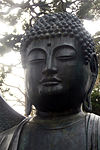
Back বিপস্যনা আন্দোলন Bengali/Bangla Vipassana liikumine Estonian विपश्यना आन्दोलन Hindi Vipasszana mozgalom Hungarian ဝိပဿနာပြန့်ပွားခြင်း Burmese Vipassanābevegelsen NB Движение медитации прозрения Russian
| Part of a series on |
| Buddhism |
|---|
 |
| Part of a series on |
| Western Buddhism |
|---|
 |
The Vipassanā movement, also called (in the United States) the Insight Meditation Movement and American Vipassana movement, refers to a branch of modern Burmese Theravāda Buddhism that promotes "bare insight" (sukha-Vipassana) to attain stream entry and preserve the Buddhist teachings,[1] which gained widespread popularity since the 1950s, and to its western derivatives which have been popularised since the 1970s, giving rise to the more dhyana-oriented mindfulness movement.[web 1]
The Burmese Vipassana movement has its roots in the 19th century, when Theravada Buddhism came to be influenced by western modernism,[2] and some monks tried to restore the Buddhist practice of meditation. Based on the commentaries, Ledi Sayadaw popularized Vipassana meditation for lay people, teaching samatha and stressing the practice of satipatthana to acquire Vipassana (insight) into the three marks of existence as the main means to attain the beginning of awakening and become a stream-enterer.[web 1]
It was greatly popularized in the 20th century in traditional Theravada countries by Mahasi Sayadaw, who introduced the "New Burmese Satipatthana Method". It also gained a large following in the west, due to westerners who learned Vipassana from Mahasi Sayadaw, S. N. Goenka, and other Burmese teachers. Some also studied with Thai Buddhist teachers, who are more critical of the commentarial tradition, and stress the joined practice of samatha and Vipassana.[web 1]
The 'American Vipassanā movement' includes contemporary American Buddhist teachers such as Joseph Goldstein, Tara Brach, Gil Fronsdal, Sharon Salzberg, Ruth Denison, Shinzen Young and Jack Kornfield.
Most of these teachers combine the strict Burmese approach with the Thai approach, and also other Buddhist and non-Buddhist ideas and practices, due to their broader training and their critical approach to the Buddhist sources.[3] And while the New Burmese Method is strictly based on the Theravāda Abhidhamma and the Visuddhimagga, western teachers tend to base their practice also on personal experience and on the suttas, which they approach in a more textual-critical way.
A recent development, according to some western non-monastic scholars, is the understanding that jhana, as described in the nikayas, is not a form of concentration-meditation, but a training in heightened awareness and equanimity, which forms the culmination of the Buddhist path.[4][5]
Cite error: There are <ref group=web> tags on this page, but the references will not show without a {{reflist|group=web}} template (see the help page).
© MMXXIII Rich X Search. We shall prevail. All rights reserved. Rich X Search